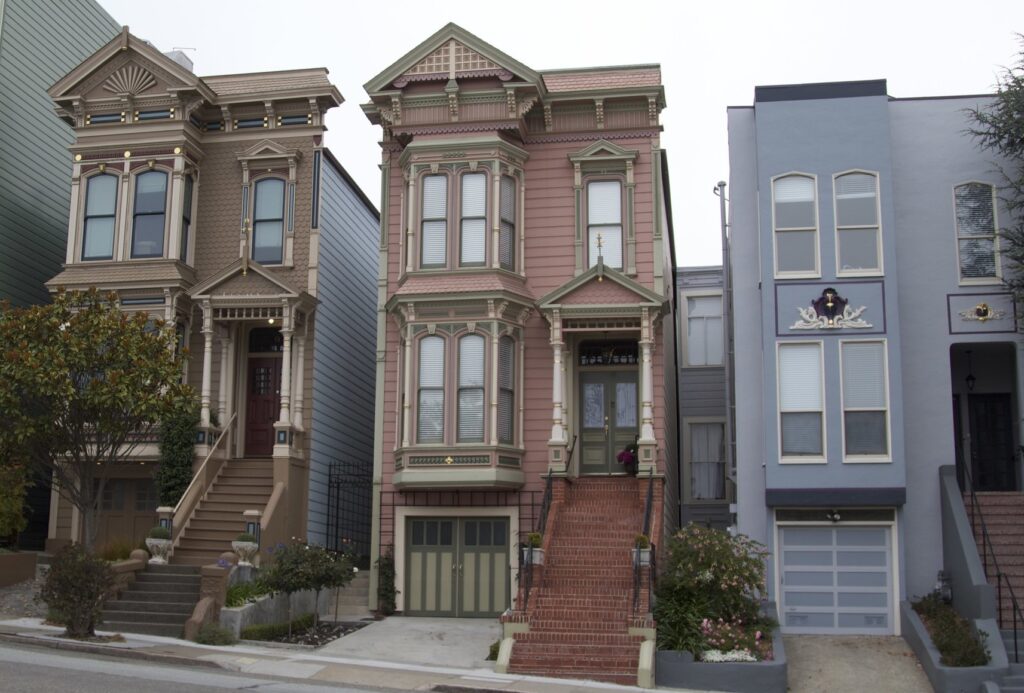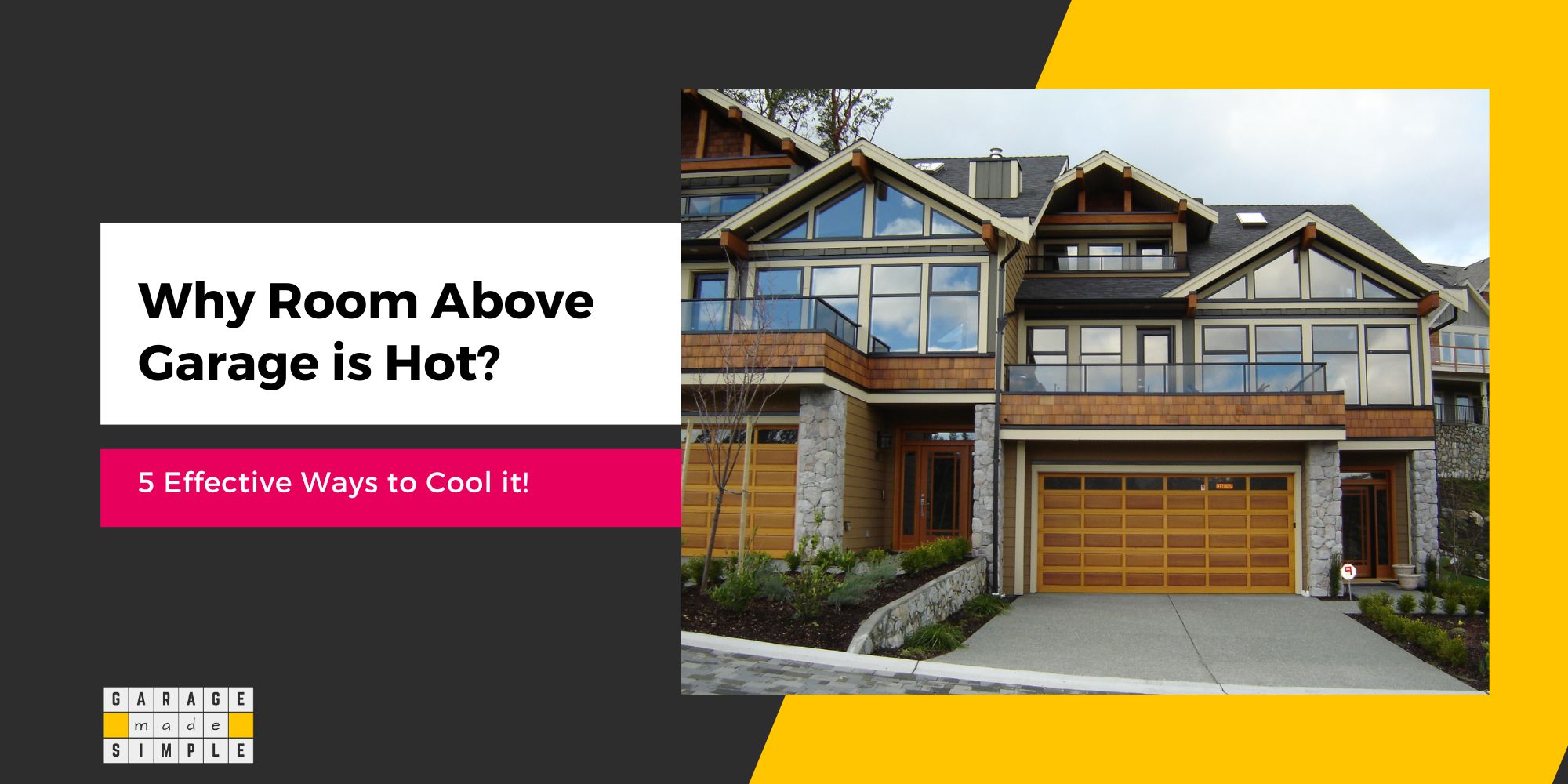10 Important Potential Garage Under House Problems!
As an Amazon Associate, I earn from qualifying purchases.
A detached garage is not connected with the house. In fact it must be at least 3’ away. An attached garage shares at least one wall (sometimes two) with the house. These are the two most popular options. But there is a third. Garage Under a House.
So, can you put a garage under a house? Yes you can! But read this before you jump into it.

Potential Problems with Garage Under House
Building a garage under house may be a necessity, due to shortage of space and a need to keep the home footprint small. It can be done but it comes with a set of challenges and potential problems that demand your attention.
Here are the important ones:
1. Dealing with Design & Construction Complexity
Building a garage under your house is an intricate process, demanding meticulous planning and execution. The design and construction complexity associated with this endeavor can not be underestimated.
You have to engage a reputed team of architects, structural engineers and experienced contractors to ensure every detail is carefully designed and constructed. You may not have the expertise, but you will need to educate yourself in some basic civil engineering to understand and monitor the work of your team.
2. Subgrade Construction Challenges
A garage under a house may be
- Above grade but have all three walls within the house (aka “integral” or “built-in” garage)
- Partially above grade and partially below grade (such as that on a slope)
- Completely below grade (aka “basement” garage)
Grappling with subgrade construction poses challenges quite different from above grade construction. Structural engineers need to take multiple soil sample to understand its exact nature and develop foundation design to accommodate ground movement and soil erosion concerns.

The excavation process can disrupt the adjoining natural terrain. So the excavation may have to be done in stages and retaining walls or other ground stabilization measures are put in place. Careful planning and day-to-day coordination between the design, engineering and construction team is crucial.
3. High Cost of Construction
The complexity of design and construction of a residence, that incorporates a garage under house, significantly escalates the overall costs. Expertise comes at a premium, and rightly so. Hiring professionals who understand the intricate nature of such a complex project is non-negotiable.
The high cost of construction can only be offset by the savings in land use. Naturally, building a garage under house would make perfect sense in the downtown of a large city, but no sense in a suburban town.
At-grade garage under house will cost around the same, or even a bit lower than the cost of an attached garage. The fact that the garage shares the foundation and three walls help bring the cost down.
However, you may have to spend extra to meet building code for the walls and especially the plywood or drywall garage ceiling. Ventilation costs will also be higher as you can not put windows in the garage and take advantage of natural airflow.
A garage that is partially or fully under grade will certainly cost a lot more than a similar detached garage. The additional costs are due to
- Cost of excavation & structurally sound foundation
- Cost of waterproofing & special drainage
- Cost of ventilation
A basement for 2 or 3 cars can add between $100K and $200K to a new house budget.
Nonetheless, even when the high cost of construction is justified by the high land prices, you still need to be very conscious and meticulous about budgeting.
4. Steep Driveway Slope
Constructing a garage beneath your house demands that the driveway must be sloped inward, towards the garage. The driveway gradient could be a challenge, as within a city you may not have enough space to design a gently sloping driveway.
The ultimate slope of the driveway leading to the garage under house influences the design requirement for driveway water diversion, trench drains and other flood prevention measures. This brings us to the next garage under house problem.
5. Flood Risk Management, Waterproofing and Drainage
Being below ground level, the garage under the house is susceptible to water ingress during heavy rains or flooding.
Water can enter the garage from the inward sloping driveway, during and just after torrential rains. Water can seep into the garage, also because of a rise in water table level. To mitigate the flood risk you need water diversion, drainage and waterproofing.
Thorough waterproofing measures, including sealing garage foundations and walls, are vital to keep your garage dry and secure. A French Drain around the garage parameter can help drain away ground water before it can enter the subgrade foundations and walls.
A driveway trench drain can collect the water rushing down the driveway and safely divert it to the storm water drain system using sump pumps. There are solutions, but they cost money and will push up the overall budget for the garage underneath the house.
Garage Partially Below Grade
A garage can be partially below grade if your house is built on a slope or a hill. To prevent flooding of such a garage, the design must take soil erosion into account.
Soil Erosion
The effects of soil erosion can be minimized by:
- Build a Retaining Wall: A retaining wall takes the load of the high ground so that it is not transmitted to the house or the garage.
- Use Mulch to Landscape: It is best to use it along with a retaining wall and not as an alternative.
Drainage
The role of external drainage becomes quite important. A garage partially or completely under grade can get flooded if the water table was to rise. Installing a French Drain around the perimeter of the house is very helpful.
The section of the French Drain that is perpendicular to the slope and uphill, should be a perforated PVC pipe that is embedded into the soil. The pipe should be placed in a U-shaped waterproof concrete trench.
Another option is to install a “trench drain” between the garage and the driveway.
Waterproofing
Proper waterproofing of the garage foundation and the walls will ensure that groundwater does not seep into the garage. Sometimes, contractors may use damp proofing instead of waterproofing.
Damp proofing may be OK for foundations built on level ground but it is not enough for foundations built on a steep slope. Only waterproofing and not damp proofing will prevent flooding.
To know more about how to build a garage on a slope, read my earlier post, The Best Way Of Building Garage On Steep Slope (Helpful!).
Garage Completely Below Grade
Flooding in a Basement Garage is prevented in the same way as flooding is prevented in a basement. The most important elements to take care of, while constructing a Basement Garage are:
- Waterproofing – the same principles, as those applicable for garage partially under grade, are applicable
- Perimeter Drainage – the same principles, as those applicable for garage partially under grade, are applicable
- Weeping Tiles – A Weeping Tile System can be installed inside the Basement Garage to catch & direct water seepage to a French Drain.
6. Code Compliance for Walls & Ceiling
R302.6 Dwelling Garage Fire Separation (applies to adjoining Garage Walls & Ceilings) states that
The garage shall be separated as required by Table R302.6. Openings in garage walls shall comply with Section R302.5. This provision does not apply to garage walls that are perpendicular to the adjacent dwelling unit wall.
Table R302.6
| Separation | Material |
| From the residence and attics | Not less than ½-inch gypsum board or equivalent applied to the garage side |
| From all habitable rooms above the garage | Not less than 5⁄8 -inch Type X gypsum board or equivalent |
| Structure(s) supporting floor-ceiling assemblies used for separation required by this section | Not less than ½-inch gypsum board or equivalent |
| Garages located less than 3 feet (914 mm) from a dwelling unit on the same lot | Not less than ½-inch gypsum board or equivalent applied to the interior side of exterior walls that are within this area |
In case of a garage under a house, the code applies to all walls, the ceiling and the door to the house.
The exception would be a basement garage, as there may be no living space adjacent to the garage walls, just grade!
7. Code for Fire Door between the Garage and House
The Garage Entry Door may be leading directly into the living room or through a flight of stairs. The good thing is that the garage will be lower than the living space.
The opening between the garage and the house must be equipped with a door that provides protection per Section R302.5.1 of the 2018 edition of the International Residential Code (IRC).
R302.5.1 Opening protection: Openings from a private garage directly into a room used for sleeping shall not be permitted. Other openings between the garage and the residence shall be equipped with solid wood doors not less than 1-3/8 inches (35 mm) in thickness, solid or honey-comb core steel doors not less than 1-3/8 inches (35 mm) thick, or 20 minute fire-rated doors equipped with a self-closing or automatic-closing device.
To be fair the “Code Compliance” is essential and is the same as that for an attached garage.
In all cases, some part of the living area of the house will be directly above the garage ceiling.
A garage under a house is not very popular, but in certain situations it may be the only option or even a desirable option. If you must put a garage under a house, you need to ask (and get answers) to 6 important questions.
8. Building Permission for Garage Under a House
You always need a a building permit from your local building authority, for constructing any structure. A garage under a house is a form of attached garage. If it is completely underground then it will also be classified as basement, as well.
The building code relevant to an attached garage will apply to all three types of garage under house. For a garage which is partially or completely under grade, the building code for basements will apply too.
The local building code is generally based on the 2021 edition of the International Residential Code (IRC). However, your local municipality may have made some modifications or additions to the IRC.
Your local architect and contractor will be well aware of all the rules & regulations. Insist that they do not cut any corners and follow the code, both in spirit and in letter. You do not want to discover any code violations in the future. Remedial action can be quite expensive.
You should try to get familiar with some important sections of IRC:
Section R302 of the 2021 edition of the International Residential Code (IRC) specifies the code for fire resistant construction.
Section R309 of the 2021 edition of the International Residential Code (IRC) specifies the code for garages and carports.
Section R322 of the 2021 edition of the International Residential Code (IRC) specifies the code for flood resistant construction.
9. Safety Concerns of a Basement Garage
In addition to adequate fire and flood protection you have to really be concerned about the ventilation of a garage under the house. Poor ventilation can be bad for your family’s health. In the worst case scenario, it can even be fatal.
Fumes, Smoke & VOC
Your garage is primarily designed to park automobiles. Leaks and spills of “combustible liquids” such as gasoline and motor oil are a distinct possibility.
But, even more dangerous is the fact that the exhaust of a car has a deadly gas; Carbon Monoxide (CO). CO is colorless, odorless and lighter than air. It can rise up and even enter your house, if the garage is not well sealed.
If you breathe in a lot of CO it can make you pass out or kill you. People who are sleeping or drunk can die from CO poisoning before they have symptoms.
https://www.cdc.gov/co/faqs.htm
A garage needs its own independent ventilation system as the building code prohibits you from connecting the house HVAC ducts to the garage.
The more your garage is under grade, the more difficult it is to achieve sufficient ventilation, for obvious reasons.
Mini Split Ductless Air Conditioner
Some, though not all, tips from my blog post Really Easy Ways To Vent A Garage With No Windows will be helpful. A Mini Split Ductless Air Conditioner is a good option for ventilation and climate control.
It is important to get the model which has sufficient cooling power for your needs. Typically an 18000 BTU should be fine for a 3 car garage. Check out 18000 BTU Mini Split Ductless Air Conditioner with 1.5 Ton Heat Pump AC/Heating System on Amazon.
- 18000 BTU Mini Split Ductless Air Conditioner from Air-Con Int.
- It is a high efficiency air conditioner, heater and dehumidifier all in one.
- Built with pro-grade materials for a long life.
- WIFI ready with optional additional remote.
Air Purifier
An air purifier in the garage is extremely helpful. A garage air purifier will
- Filter out dust, pet dander & allergens
- Kill mold spores, bacteria & viruses
- Eliminate fumes, smoke & VOC
An air purifier using activated carbon will be able to absorb the dangerous fumes and vapors. My recommendation is to go for Bissell air400 Professional Air Purifier with HEPA and Carbon Filters from Amazon.

10. Quite Inconvenient
A basement garage can be very inconvenient as you will end up carrying groceries and other heavy shopping items upstairs. The inconvenience is further compounded if you have small kids.
Since a basement garage is below grade, it also tends to be too cold, especially in winters. You will certainly need some extra insulation for your garage. You may even need to install heaters.
A freezing garage can actually become a slip hazard as the water drip from cars or moisture condensation will turn to a thin layer of ice on the garage floor, overnight.
Thank you very much for reading the post. I do hope you found it informative and useful.






